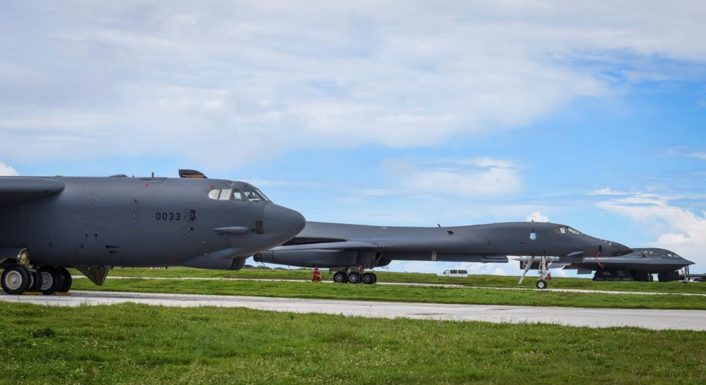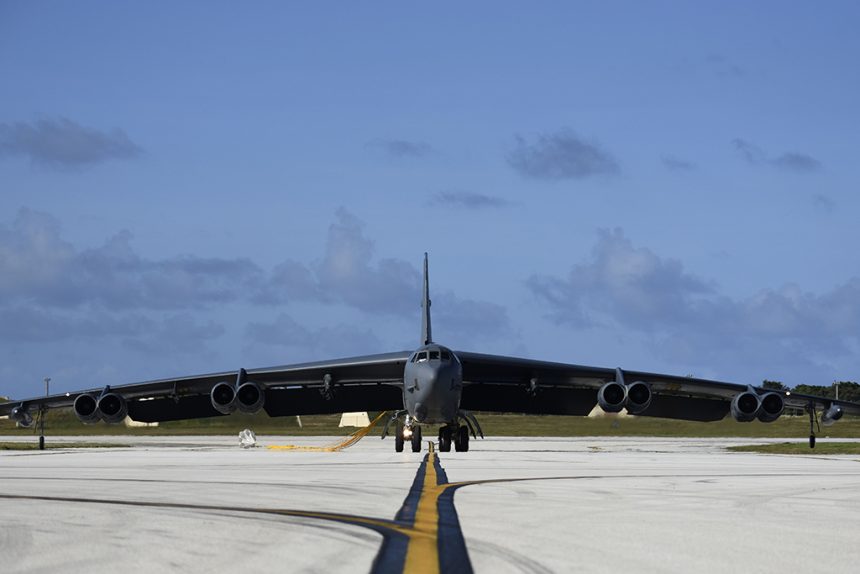The U.S. Air Force bomber trio (B-52, B-2 and B-1) currently deployed to Guam: it’s the second time since August 2016.
Six B-52H bombers and approximately 300 Airmen from Barksdale Air Force Base, Louisiana, are deploying to Andersen AFB, Guam, in support of U.S. Pacific Command’s Continuous Bomber Presence mission. Two Stratofortresses have arrived in Guam on Jan. 15; the rest are expected to deploy in the next hours. They join six B-1s and three B-2s already in Guam.
The iconic B-52 bombers will relieve the B-1B Lancers that deployed from Ellsworth AFB, South Dakota, on Aug. 6, 2016, as part of their first CBP deployment in support of the U.S. Pacific Command’s (USPACOM) deterrence efforts in the Indo-Asia-Pacific region in 10 years.
During their deployment, the 37th EBS conducted a variety of joint and bilateral training missions with the U.S. Navy, U.S. Marine Corps, Japan Air Self-Defense Force, South Korean air force and Royal Australian Air Force, including some symbolic shows of force against North Korea alongside the U.S. Marine Corps F-35B forward based in Japan.

Noteworthy, at the beginning of their tour of duty in the Pacific in 2016, the B-1s replaced another B-52 detachment: the 69th EBS from Minot AFB, ND. Before the Stratofortress bombers started returning home, three B-2s arrived in Guam for a “short-term deployment”: exploiting the presence of the three bomber types on the very same forward operating base, on Aug. 17, 2016, the U.S. Air Force conducted the first coordinated operation in the U.S Pacific Command AOR (Area Of Operations) launching three aircraft (1x B-2, 1x B-52 and 1x B-1) in sequence from Andersen Air Force Base to conduct simultaneous operations in the South China Sea and Northeast Asia.
Considered the presence of B-52s, B-2s and B-1s once again together at the same time in Guam will give the U.S. Air Force the opportunity to launch again the trio in an integrated bomber operation in the Pacific similar to the one carried out in the Summer of 2016.
“The B-52H’s return to the Pacific will provide USPACOM and its regional allies and partners with a credible, strategic power projection platform, while bringing years of repeated operational experience. The B-52 is capable of flying at high subsonic speeds at altitudes up to 50,000 feet (15,166.6 meters) and can carry nuclear or precision guided conventional ordnance with worldwide precision navigation capability. This forward-deployed presence demonstrates the continued commitment of the U.S.to allies and partners in the Indo-Pacific region,” says the U.S. Air Force official release.
The B-52 deployment in support of the CBP missions brings again a constant (at least until the next rotation) nuclear bomber capability within striking distance of North Korea.
Meanwhile, four B-52H Stratofortress aircraft have arrived in the UK for theatre integration and training at RAF Fairford. The aircraft are from the 5th Bomb Wing at Minot Air Force Base, North Dakota, and will conduct theatre integration and training in Europe.
Many “Buffs” deployed across the globe!









